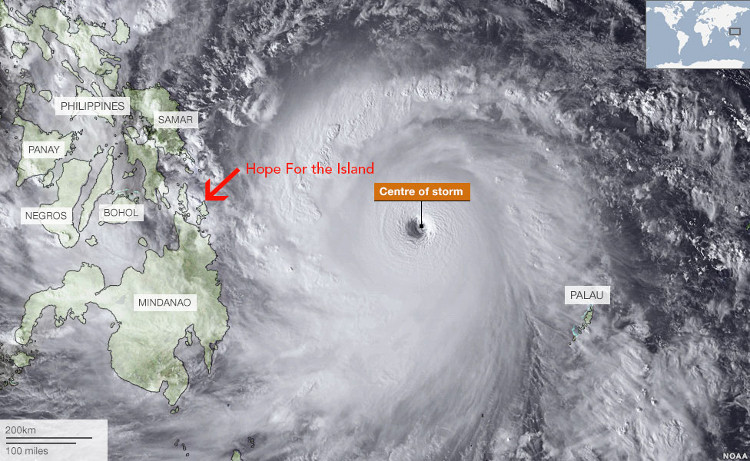Natural phenomena have the most destructive power
Storms, earthquakes, volcanic eruptions are natural phenomena that contain huge amounts of energy, which can cause catastrophic disasters for humans.
Storm
One of the strongest storms in human history is Typhoon Haiyan , which hit the Philippines in 2013, with winds of 314km / h, according to IFL Science. In the Western Hemisphere, Patricia is the strongest storm to hit Mexico in 2015 with maximum winds of 325km / h.

Satellite image of super typhoon Haiyan.(Photo: NOAA).
In 1961, super typhoon Nancy , a tropical cyclone on the northwest Pacific region, had the highest wind speed in history, about 346km / h. The National Oceanic and Atmospheric Administration (NOAA) estimates that the storm releases an average of 600 trillion jun (J) of energy per second in the rain cloud and 1.5 trillion J in dynamic form. wind power.
In fact, average storms produce an energy equivalent of 600 million lightning strikes per second.
Earthquake
Today, scientists measure their strength based on torque scale (Mw). The strongest earthquake in history took place on May 22, 1960 in southern Chile with a magnitude of 9.5 Mw, releasing energy of about 8.3 billion J in just a few seconds.
Volcanic eruption
Some volcanic eruptions can form huge columns of dust and lava.St. Volcano Helens is known for the most deadly eruption in American history in 1980. The ash from the eruption spreads almost 1,600km, killing 57 people. The volcano continued to wake up in 2004, spewing out a ash column over 9,000m high.

Calbuco, Chile volcano, erupted in April 2015.(Photo: IFL Science).
The most powerful volcanic eruption in the last 500 million years is believed to have occurred at La Garita, the super volcano has stopped working in Colorado, USA. 28 million years ago, this volcano sprayed 5,000 km 3 of dust and lava in just a few hours or days, enough to bury California state under 12m of ash, with energy released at about 1,050 billion J .
Collision with asteroids
When comets or asteroids crash into the Earth, they can cause massive storms and tsunamis, which change global temperatures. Dust from the collision obscures the sunlight, preventing the photosynthesis of trees, destroying the entire food chain.

Life on Earth is threatened if it collides with a large asteroid.(Photo: Alamy).
An asteroid 10km in diameter in the past could be the culprit who destroyed all dinosaurs colliding with the Earth, releasing energy of 543,000 billion J, 1,000 times more than the energy a storm created throughout the day.
According to scientists, the Moon formed after an early collision with the Earth with a small planet called Theia about 4.5 billion years ago.
- Strange phenomena will help you realize the true power of nature
- The most incredible natural phenomena in the world
- 8 natural scientific phenomena cannot explain
- Discover unique natural phenomena
- Scary but beautiful natural phenomena
- 'Rare and difficult to find' natural phenomena
- 8 beautiful natural phenomena only available in Australia
- Strange natural phenomena only occur when it is cold
- 10 strange natural phenomena that cannot explain in the Solar System
- Supernatural and mystical phenomena are real?
- 10 shocking facts about the brutality of floods
- Top 15 strange natural phenomena (1)
 Is the magnetic North Pole shift dangerous to humanity?
Is the magnetic North Pole shift dangerous to humanity? Washington legalizes the recycling of human bodies into fertilizer
Washington legalizes the recycling of human bodies into fertilizer Lightning stone - the mysterious guest
Lightning stone - the mysterious guest Stunned by the mysterious sunset, strange appearance
Stunned by the mysterious sunset, strange appearance Simulating Einstein's formula, scientists prove that light can create matter
Simulating Einstein's formula, scientists prove that light can create matter  First hydrogen-powered gas turbine tested
First hydrogen-powered gas turbine tested  Does antimatter really exist?
Does antimatter really exist?  20 telescopes dazzled by 'cosmic monster' that transcends time by 8.5 billion years
20 telescopes dazzled by 'cosmic monster' that transcends time by 8.5 billion years  Why can migratory birds fly thousands of kilometers without eating?
Why can migratory birds fly thousands of kilometers without eating?  Discover the world's first reactor that can produce endless energy
Discover the world's first reactor that can produce endless energy 